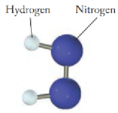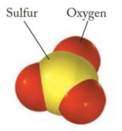
Chemistry: Principles and Practice
3rd Edition
ISBN: 9780534420123
Author: Daniel L. Reger, Scott R. Goode, David W. Ball, Edward Mercer
Publisher: Cengage Learning
expand_more
expand_more
format_list_bulleted
Question
Chapter 2, Problem 2.69QE
(a)
Interpretation Introduction
Interpretation:
Molecular formula for the given diagram has to be written.

Concept Introduction:
Molecular formula is a simple representation of a compound using the atomic symbols of the constituent elements present in it. In molecular formula, the subscript after the atomic symbol represent the number of atoms of the same element is present in the compound.
(b)
Interpretation Introduction
Interpretation:
Molecular formula for the given diagram has to be written.

Concept Introduction:
Refer part (a).
Expert Solution & Answer
Want to see the full answer?
Check out a sample textbook solution
Students have asked these similar questions
Sketch the intermediates for A,B,C & D.
Can the molecule on the right-hand side of this organic reaction be made in good yield from no more than two reactants, in one step, by moderately heating
the reactants?
O
? A
. If your answer is yes, then draw the reactant or reactants in the drawing area below. You can draw the reactants in any arrangement you like.
. If your answer is no, check the box under the drawing area instead.
Explanation
Check
Click and drag to start drawing a structure.
ㅇ
80
F5
F6
A
2025 McGraw Hill LLC. All Rights Reserved. Terms of Use | Privacy Cente
FIG
In methyl orange preparation, if the reaction started with 0.5 mole of sulfanilic acid to form the diazonium salt of this compound and then it converted to methyl orange [0.2 mole]. If the efficiency of the second step was 50%, Calculate: A. Equation(s) of Methyl Orange synthesis: Diazotization and coupling reactions. B. How much diazonium salt was formed in this reaction? C. The efficiency percentage of the diazotization reaction D. Efficiency percentage of the whole reaction.
Chapter 2 Solutions
Chemistry: Principles and Practice
Ch. 2 - Prob. 2.1QECh. 2 - State how Daltons atomic theory explains (a) the...Ch. 2 - Prob. 2.3QECh. 2 - Prob. 2.4QECh. 2 - Prob. 2.5QECh. 2 - Prob. 2.6QECh. 2 - Prob. 2.7QECh. 2 - Describe the arrangement of protons, neutrons, and...Ch. 2 - Prob. 2.9QECh. 2 - Prob. 2.10QE
Ch. 2 - A mass spectrometer determines isotopic masses to...Ch. 2 - Prob. 2.12QECh. 2 - Prob. 2.13QECh. 2 - Prob. 2.14QECh. 2 - Prob. 2.15QECh. 2 - Prob. 2.16QECh. 2 - Sulfur dioxide, SO2, is a molecular compound that...Ch. 2 - Prob. 2.18QECh. 2 - Prob. 2.19QECh. 2 - Prob. 2.20QECh. 2 - Prob. 2.21QECh. 2 - Prob. 2.22QECh. 2 - Prob. 2.23QECh. 2 - Prob. 2.24QECh. 2 - Prob. 2.25QECh. 2 - Prob. 2.26QECh. 2 - Prob. 2.27QECh. 2 - Prob. 2.28QECh. 2 - Prob. 2.29QECh. 2 - Give the complete symbol (XZA), including atomic...Ch. 2 - Prob. 2.31QECh. 2 - Prob. 2.32QECh. 2 - Prob. 2.33QECh. 2 - Prob. 2.34QECh. 2 - Prob. 2.35QECh. 2 - Prob. 2.36QECh. 2 - Prob. 2.37QECh. 2 - Prob. 2.38QECh. 2 - Prob. 2.39QECh. 2 - Prob. 2.40QECh. 2 - Prob. 2.41QECh. 2 - Prob. 2.42QECh. 2 - Prob. 2.43QECh. 2 - Prob. 2.44QECh. 2 - Prob. 2.45QECh. 2 - Prob. 2.46QECh. 2 - Prob. 2.47QECh. 2 - Prob. 2.48QECh. 2 - Prob. 2.49QECh. 2 - Prob. 2.50QECh. 2 - Prob. 2.51QECh. 2 - Prob. 2.52QECh. 2 - Prob. 2.53QECh. 2 - Prob. 2.54QECh. 2 - Prob. 2.55QECh. 2 - Prob. 2.56QECh. 2 - Prob. 2.57QECh. 2 - Prob. 2.58QECh. 2 - Prob. 2.59QECh. 2 - Prob. 2.60QECh. 2 - Prob. 2.61QECh. 2 - Prob. 2.62QECh. 2 - Prob. 2.63QECh. 2 - Prob. 2.64QECh. 2 - Prob. 2.65QECh. 2 - Prob. 2.66QECh. 2 - Prob. 2.67QECh. 2 - Prob. 2.68QECh. 2 - Prob. 2.69QECh. 2 - Prob. 2.70QECh. 2 - Prob. 2.71QECh. 2 - Prob. 2.72QECh. 2 - Prob. 2.73QECh. 2 - Prob. 2.74QECh. 2 - Prob. 2.75QECh. 2 - Prob. 2.76QECh. 2 - Prob. 2.77QECh. 2 - Prob. 2.78QECh. 2 - Prob. 2.79QECh. 2 - Prob. 2.80QECh. 2 - Prob. 2.81QECh. 2 - Prob. 2.82QECh. 2 - Prob. 2.83QECh. 2 - Prob. 2.84QECh. 2 - Prob. 2.85QECh. 2 - Prob. 2.86QECh. 2 - Prob. 2.87QECh. 2 - Prob. 2.88QECh. 2 - Prob. 2.89QECh. 2 - Prob. 2.90QECh. 2 - Prob. 2.91QECh. 2 - Prob. 2.92QECh. 2 - Prob. 2.93QECh. 2 - Prob. 2.94QECh. 2 - Prob. 2.95QECh. 2 - Prob. 2.96QECh. 2 - Write the formula of (a) manganese(III) sulfide....Ch. 2 - Prob. 2.98QECh. 2 - Prob. 2.99QECh. 2 - Prob. 2.100QECh. 2 - Prob. 2.101QECh. 2 - Prob. 2.102QECh. 2 - Prob. 2.103QECh. 2 - Prob. 2.104QECh. 2 - Prob. 2.105QECh. 2 - Prob. 2.106QECh. 2 - Prob. 2.107QECh. 2 - Prob. 2.108QECh. 2 - Prob. 2.109QECh. 2 - Prob. 2.110QECh. 2 - Prob. 2.111QECh. 2 - Prob. 2.112QECh. 2 - Prob. 2.113QECh. 2 - Prob. 2.114QECh. 2 - Prob. 2.115QECh. 2 - Prob. 2.116QECh. 2 - Prob. 2.117QECh. 2 - Prob. 2.118QECh. 2 - Prob. 2.119QECh. 2 - Prob. 2.120QECh. 2 - Prob. 2.121QECh. 2 - Prob. 2.122QECh. 2 - Prob. 2.123QECh. 2 - Prob. 2.124QECh. 2 - Prob. 2.125QECh. 2 - Prob. 2.126QECh. 2 - Prob. 2.127QECh. 2 - Prob. 2.128QECh. 2 - Prob. 2.129QECh. 2 - Prob. 2.130QECh. 2 - Prob. 2.131QECh. 2 - Prob. 2.132QECh. 2 - Prob. 2.133QECh. 2 - Prob. 2.134QECh. 2 - Prob. 2.135QECh. 2 - Prob. 2.136QE
Knowledge Booster
Learn more about
Need a deep-dive on the concept behind this application? Look no further. Learn more about this topic, chemistry and related others by exploring similar questions and additional content below.Similar questions
- Hand written equations pleasearrow_forwardHand written equations pleasearrow_forward> each pair of substrates below, choose the one that will react faster in a substitution reaction, assuming that: 1. the rate of substitution doesn't depend on nucleophile concentration and 2. the products are a roughly 50/50 mixture of enantiomers. Substrate A Substrate B Faster Rate X Ś CI (Choose one) (Choose one) CI Br Explanation Check Br (Choose one) © 2025 McGraw Hill LLC. All Rights Farrow_forward
- NMR spectrum of ethyl acetate has signals whose chemical shifts are indicated below. Which hydrogen or set of hydrogens corresponds to the signal at 4.1 ppm? Select the single best answer. The H O HỌC—C—0—CH, CH, 2 A ethyl acetate H NMR: 1.3 ppm, 2.0 ppm, 4.1 ppm Check OA B OC ch B C Save For Later Submit Ass © 2025 McGraw Hill LLC. All Rights Reserved. Terms of Use | Privacy Center |arrow_forwardHow many signals do you expect in the H NMR spectrum for this molecule? Br Br Write the answer below. Also, in each of the drawing areas below is a copy of the molecule, with Hs shown. In each copy, one of the H atoms is colored red. Highlight in red all other H atoms that would contribute to the same signal as the H already highlighted red Note for advanced students: In this question, any multiplet is counted as one signal. 1 Number of signals in the 'H NMR spectrum. For the molecule in the top drawing area, highlight in red any other H atoms that will contribute to the same signal as the H atom already highlighted red. If no other H atoms will contribute, check the box at right. Check For the molecule in the bottom drawing area, highlight in red any other H atoms that will contribute to the same signal as the H atom already highlighted red. If no other H atoms will contribute, check the box at right. O ✓ No additional Hs to color in top molecule ง No additional Hs to color in bottom…arrow_forwardin the kinetics experiment, what were the values calculated? Select all that apply.a) equilibrium constantb) pHc) order of reactiond) rate contstantarrow_forward
- true or false, given that a 20.00 mL sample of NaOH took 24.15 mL of 0.141 M HCI to reach the endpoint in a titration, the concentration of the NaOH is 1.17 M.arrow_forwardin the bromothymol blue experiment, pKa was measured. A closely related compound has a Ka of 2.10 x 10-5. What is the pKa?a) 7.1b) 4.7c) 2.0arrow_forwardcalculate the equilibrium concentration of H2 given that K= 0.017 at a constant temperature for this reaction. The inital concentration of HBr is 0.050 M.2HBr(g) ↔ H2(g) + Br2(g)a) 4.48 x 10-2 M b) 5.17 x 10-3 Mc) 1.03 x 10-2 Md) 1.70 x 10-2 Marrow_forward
- true or falsegiven these two equilibria with their equilibrium constants:H2(g) + CI2(l) ↔ 2HCI(g) K= 0.006 CI2(l) ↔ CI2(g) K= 0.30The equilibrium contstant for the following reaction is 1.8H2(g) + CI2 ↔ 2HCI(g)arrow_forwardI2(g) + CI2(g) ↔ 2ICIK for this reaction is 81.9. Find the equilibrium concentration of I2 if the inital concentration of I2 and CI2 are 0.010 Marrow_forwardtrue or false,the equilibrium constant for this reaction is 0.50.PCI5(g) ↔ PCI3(g) + CI2(g)Based on the above, the equilibrium constant for the following reaction is 0.25.2PCI5(g) ↔. 2PCI3(g) + 2CI2(g)arrow_forward
arrow_back_ios
SEE MORE QUESTIONS
arrow_forward_ios
Recommended textbooks for you
 Chemistry: Principles and PracticeChemistryISBN:9780534420123Author:Daniel L. Reger, Scott R. Goode, David W. Ball, Edward MercerPublisher:Cengage Learning
Chemistry: Principles and PracticeChemistryISBN:9780534420123Author:Daniel L. Reger, Scott R. Goode, David W. Ball, Edward MercerPublisher:Cengage Learning Chemistry: The Molecular ScienceChemistryISBN:9781285199047Author:John W. Moore, Conrad L. StanitskiPublisher:Cengage Learning
Chemistry: The Molecular ScienceChemistryISBN:9781285199047Author:John W. Moore, Conrad L. StanitskiPublisher:Cengage Learning General Chemistry - Standalone book (MindTap Cour...ChemistryISBN:9781305580343Author:Steven D. Gammon, Ebbing, Darrell Ebbing, Steven D., Darrell; Gammon, Darrell Ebbing; Steven D. Gammon, Darrell D.; Gammon, Ebbing; Steven D. Gammon; DarrellPublisher:Cengage Learning
General Chemistry - Standalone book (MindTap Cour...ChemistryISBN:9781305580343Author:Steven D. Gammon, Ebbing, Darrell Ebbing, Steven D., Darrell; Gammon, Darrell Ebbing; Steven D. Gammon, Darrell D.; Gammon, Ebbing; Steven D. Gammon; DarrellPublisher:Cengage Learning Chemistry: Principles and ReactionsChemistryISBN:9781305079373Author:William L. Masterton, Cecile N. HurleyPublisher:Cengage Learning
Chemistry: Principles and ReactionsChemistryISBN:9781305079373Author:William L. Masterton, Cecile N. HurleyPublisher:Cengage Learning Introductory Chemistry: A FoundationChemistryISBN:9781337399425Author:Steven S. Zumdahl, Donald J. DeCostePublisher:Cengage Learning
Introductory Chemistry: A FoundationChemistryISBN:9781337399425Author:Steven S. Zumdahl, Donald J. DeCostePublisher:Cengage Learning Chemistry & Chemical ReactivityChemistryISBN:9781337399074Author:John C. Kotz, Paul M. Treichel, John Townsend, David TreichelPublisher:Cengage Learning
Chemistry & Chemical ReactivityChemistryISBN:9781337399074Author:John C. Kotz, Paul M. Treichel, John Townsend, David TreichelPublisher:Cengage Learning

Chemistry: Principles and Practice
Chemistry
ISBN:9780534420123
Author:Daniel L. Reger, Scott R. Goode, David W. Ball, Edward Mercer
Publisher:Cengage Learning

Chemistry: The Molecular Science
Chemistry
ISBN:9781285199047
Author:John W. Moore, Conrad L. Stanitski
Publisher:Cengage Learning

General Chemistry - Standalone book (MindTap Cour...
Chemistry
ISBN:9781305580343
Author:Steven D. Gammon, Ebbing, Darrell Ebbing, Steven D., Darrell; Gammon, Darrell Ebbing; Steven D. Gammon, Darrell D.; Gammon, Ebbing; Steven D. Gammon; Darrell
Publisher:Cengage Learning

Chemistry: Principles and Reactions
Chemistry
ISBN:9781305079373
Author:William L. Masterton, Cecile N. Hurley
Publisher:Cengage Learning

Introductory Chemistry: A Foundation
Chemistry
ISBN:9781337399425
Author:Steven S. Zumdahl, Donald J. DeCoste
Publisher:Cengage Learning

Chemistry & Chemical Reactivity
Chemistry
ISBN:9781337399074
Author:John C. Kotz, Paul M. Treichel, John Townsend, David Treichel
Publisher:Cengage Learning
GCSE Chemistry - Differences Between Compounds, Molecules & Mixtures #3; Author: Cognito;https://www.youtube.com/watch?v=jBDr0mHyc5M;License: Standard YouTube License, CC-BY